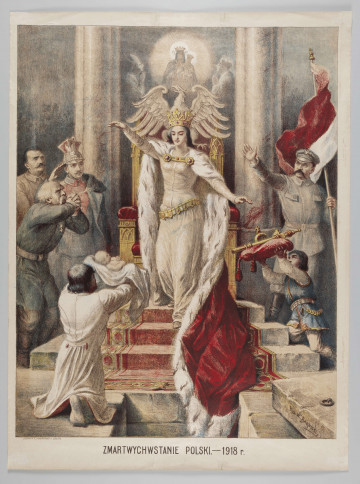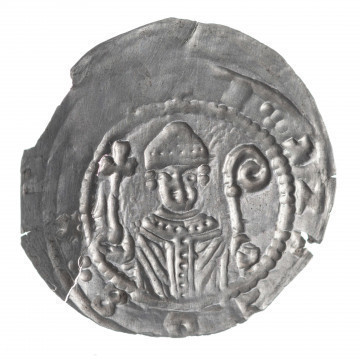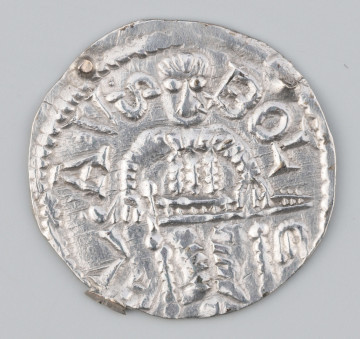
Resurrection of Poland
1918
National Museum in Lublin
Part of the collection: Money on Polish territory in the Middle Ages
Besides issuing bilateral denars with images on both obverse and reverse sides, Bolesław the Wrymouthed (1102/1107-1138) - issued two types of one-sided denars, struck on a very thin disk using a single stamp. These were called bracteates (Latin bractea – plate). They were characterised by a large diameter and at the same time larger space for iconographic and ideological content. The first type shows the figure of St Adalbert carrying the Pallium, a Gospel book and a pastoral. The second type depicts a prince kneeling before St. Adalbert with Adalbert’s right hand resting on the ruler's head.
The circumstances of the issue of brakteats, their chronology and relation to bilateral denars are still being discussed.
The issue of the brakteate with the saint and the prince has been linked with an attempt made in the 1130s to make the Polish Church dependent on the Magdeburg metropolis, and with the fief homage paid by the Polish prince to Emperor Lothar in Merseburg (1135). The response to these events was to be a scene interpreted as an act of submission of the prince and the state to the protection of St Adalbert. The issue, dated 1135, was intended to strengthen the position of the ruler at home, weakened by the international situation. Another concept assumes that the introduction of bracteates was economically motivated and was linked to plans to introduce a reform of the monetary system in Poland, according to the practice applied in Saxony at that time. It would consist in increasing the frequency of money exchange to ensure the ruler a greater profit from minting production. That was to be achieved by the bracteate technique, which improved and enhanced the efficiency of the mint. The scene depicted on the bracteate was supposed to strengthen the position of the prince in the society, which lost money during the money exchange. Another interpretation assumes that the issue of this bracteate was connected to obtaining absolution by the prince after the murder of his brother, Zbigniew (1113). The representation on the coin illustrates the moment of absolution and the prince's submission to the protection of the patron of Poland. These brakteates were to be minted throughout the whole reign, which is indicated above all by the results of the analysis of the content of the stamps and the weights of the coins. A long period of production is supported by the fact that nearly 100 stamps, with which over 600 known specimens were struck, have been identified to date. It is most likely that the coins were made in Kraków.
Tomasz Markiewicz
Author / creator
Dimensions
cały obiekt: diameter: 14,2 mm
Object type
numismatic
Technique
stamp minting
Material
silver
Creation time / dating
Creation / finding place
Owner
The National Museum in Lublin
Identification number
Location / status

1918
National Museum in Lublin

1254
National Museum in Lublin

1146 — 1152
National Museum in Lublin
DISCOVER this TOPIC
Museum of King Jan III's Palace at Wilanów
DISCOVER this PATH
Educational path